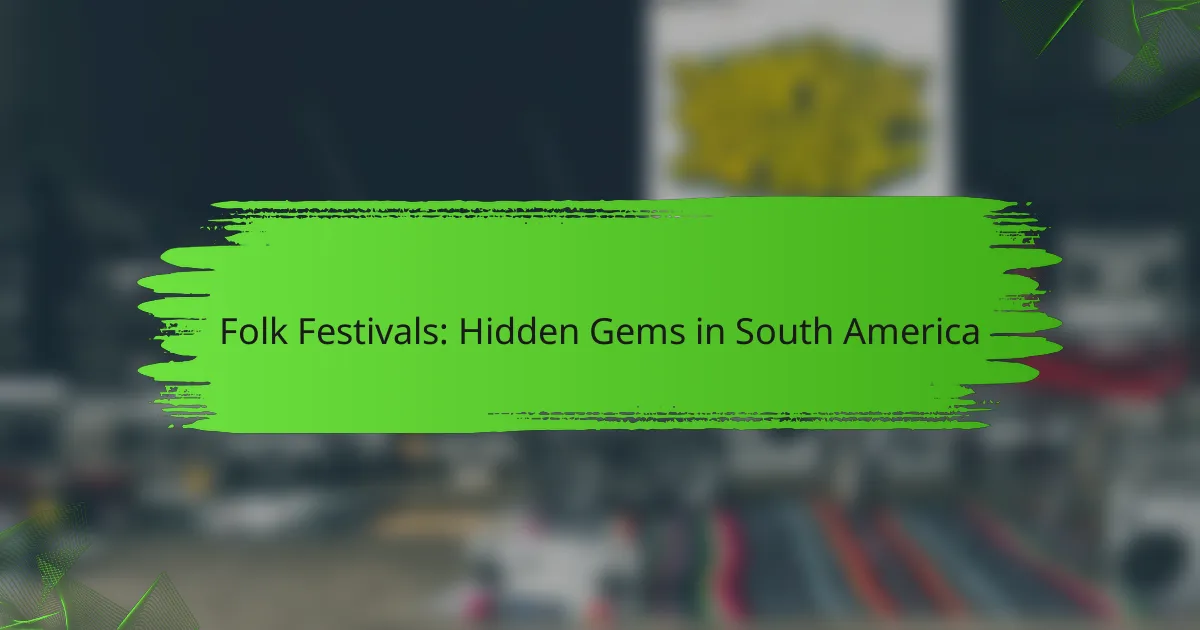South America boasts a plethora of vibrant folk festivals that celebrate the continent’s rich cultural tapestry. These events offer travelers a unique opportunity to experience traditional music, dance, and local cuisine, immersing themselves in the diverse customs and artistry of various regions. Whether you’re planning your visit or simply curious about these hidden gems, exploring these festivals can deepen your appreciation for South America’s cultural heritage.

Which folk festivals are must-visit in South America?
South America is home to a variety of vibrant folk festivals that showcase the continent’s rich cultural heritage. Notable events include traditional music, dance, and local cuisine, making them essential experiences for travelers.
Inti Raymi in Cusco, Peru
Inti Raymi, or the Festival of the Sun, is celebrated every June 24th in Cusco, marking the Inca New Year. This colorful event features elaborate reenactments of ancient rituals, with thousands of participants dressed in traditional attire.
Visitors can enjoy performances at the Sacsayhuamán archaeological site, where the main ceremony takes place. Arriving early is advisable to secure a good viewing spot, as the event attracts large crowds.
Feria de las Flores in Medellín, Colombia
The Feria de las Flores, held in early August, is a celebration of Medellín’s flower industry and cultural heritage. The festival includes parades, concerts, and flower displays, showcasing the city’s vibrant atmosphere.
One of the highlights is the “Desfile de Silleteros,” where local farmers carry elaborate flower arrangements on their backs. Attending this festival offers a unique insight into Colombian traditions and the importance of flowers in local culture.
Festival de la Cerveza in Blumenau, Brazil
Blumenau’s Festival de la Cerveza, typically held in October, is Brazil’s largest beer festival, inspired by Munich’s Oktoberfest. This event features a variety of local and international beers, traditional German food, and lively music.
Visitors can participate in beer tastings, enjoy cultural performances, and experience the festive atmosphere. It’s recommended to book accommodations in advance, as the festival draws large crowds from across the country.
Fiesta de la Vendimia in Mendoza, Argentina
The Fiesta de la Vendimia, celebrated in March, marks the grape harvest in Mendoza, Argentina’s renowned wine region. This festival includes parades, wine tastings, and cultural events that highlight the importance of viticulture in the area.
One of the main attractions is the election of the Harvest Queen, accompanied by a grand show featuring music and dance. Attending this festival provides an excellent opportunity to sample local wines and experience Argentine culture.
Festival Internacional de Guitarra in Montevideo, Uruguay
The Festival Internacional de Guitarra, held annually in Montevideo, celebrates guitar music from various genres, including classical, jazz, and folk. This event attracts musicians and enthusiasts from around the world, making it a hub for guitar lovers.
Workshops, concerts, and competitions are part of the festival, providing opportunities for attendees to learn and engage with artists. It’s advisable to check the festival schedule in advance to catch the most anticipated performances and events.

What unique experiences do South American folk festivals offer?
South American folk festivals provide vibrant cultural experiences that showcase traditional music, dance, and local cuisine. Attendees can immerse themselves in the rich heritage of various regions, gaining insights into the customs and artistry that define these communities.
Traditional music and dance
Folk festivals in South America are renowned for their lively traditional music and dance performances. Each region has its unique styles, such as the Andean sounds of pan flutes and charangos or the rhythmic beats of samba and cumbia. Participating in these dances often invites festival-goers to join in, creating a communal atmosphere.
Many festivals feature competitions where local groups showcase their talents, providing an opportunity to witness the diversity of cultural expressions. For example, the Festival de la Canción Criolla in Peru highlights Creole music and dance, drawing large crowds and fostering a sense of pride in local heritage.
Local culinary delights
Food is a central element of South American folk festivals, with vendors offering a variety of local dishes. Attendees can sample traditional foods such as empanadas, arepas, and tamales, often made from regional ingredients. These culinary experiences not only satisfy hunger but also reflect the cultural identity of the area.
Some festivals even host cooking demonstrations or competitions, allowing visitors to learn about the preparation of these dishes. Engaging with local chefs can enhance understanding of the culinary traditions and the significance of certain ingredients, making the experience even more enriching.
Cultural workshops and crafts
Many folk festivals include workshops where participants can learn traditional crafts and skills. These workshops may cover areas such as weaving, pottery, or painting, often led by local artisans who share their expertise. Engaging in these activities provides a hands-on connection to the culture and its artistic expressions.
Attendees can also purchase handmade crafts directly from artisans, supporting local economies and preserving traditional techniques. This interaction fosters a deeper appreciation for the craftsmanship involved and the stories behind each piece, making for a memorable festival experience.

How to plan a trip to South American folk festivals?
Planning a trip to South American folk festivals involves selecting the right time to visit, finding suitable accommodations, and understanding local transportation options. Consider the festival dates, regional climate, and cultural significance to enhance your experience.
Best travel seasons
The best travel seasons for South American folk festivals typically align with the summer months, from December to March, when many festivals occur. However, some regions may host events during the winter months, such as June and July, particularly in the Andes.
Research specific festivals to determine their dates, as they can vary significantly from year to year. For example, the Carnival in Rio de Janeiro takes place in February, while the Inti Raymi Festival in Cusco is celebrated in June.
Accommodation options
Accommodation options near folk festivals range from budget hostels to mid-range hotels and luxury lodges. In popular festival cities like Cusco or Salvador, booking in advance is advisable, especially during peak festival times.
Consider staying in local guesthouses or Airbnb rentals for a more authentic experience. These options often provide insights into local culture and may include meals or guided tours.
Transportation tips
Transportation to and from folk festivals can vary greatly depending on the location. Major cities often have reliable public transport systems, including buses and taxis, but rural areas may require renting a car or using local shuttles.
For long distances, consider domestic flights, as they can save time compared to bus travel. Always check local transportation schedules in advance, especially during festival periods when demand increases.

What are the cultural significances of these festivals?
Folk festivals in South America hold deep cultural significance, serving as vital expressions of identity, tradition, and community. They are essential for preserving local customs and fostering social cohesion among diverse groups.
Preservation of indigenous traditions
These festivals play a crucial role in maintaining and revitalizing indigenous traditions that might otherwise fade. Through music, dance, and storytelling, communities pass down their heritage to younger generations, ensuring that unique cultural practices remain vibrant.
For instance, festivals like Inti Raymi in Peru celebrate ancient Incan rituals, showcasing traditional clothing, food, and ceremonies that honor ancestral beliefs. Such events often attract both locals and tourists, creating a shared space for cultural exchange.
Community bonding and celebration
Folk festivals foster a sense of belonging and unity among community members. They provide opportunities for people to come together, celebrate their shared heritage, and strengthen social ties through collective participation.
Events like the Carnival in Brazil exemplify this spirit, where vibrant parades and communal activities encourage collaboration and joy. These gatherings often feature local artisans, musicians, and food vendors, reinforcing local economies while enhancing community pride.

How do folk festivals in South America compare to those in other regions?
Folk festivals in South America are distinct for their vibrant cultural expressions and deep-rooted traditions, often reflecting the region’s diverse indigenous and colonial histories. Compared to other regions, these festivals showcase unique music, dance, and crafts that are integral to local identities.
Differences in cultural expressions
South American folk festivals often emphasize indigenous heritage, featuring traditional music styles like Andean folk or Brazilian samba, which may not be as prevalent in other areas. For example, the Inti Raymi festival in Peru celebrates the Inca sun god with elaborate rituals, while the Festa Junina in Brazil highlights rural life through folk dances and traditional foods.
In contrast, folk festivals in Europe may focus more on medieval traditions or regional folklore, showcasing different historical influences. This results in a rich tapestry of performances that can vary significantly from one continent to another, reflecting local customs and societal values.
Similarities in community involvement
Community involvement is a hallmark of folk festivals worldwide, including those in South America. Local residents often participate not just as spectators but as active contributors, whether through performances, crafts, or food stalls. This engagement fosters a sense of belonging and pride among participants.
Moreover, like many folk festivals globally, South American events often encourage collaboration across generations, with families passing down traditions and skills. This intergenerational aspect strengthens community ties and ensures the preservation of cultural heritage, making these festivals vital to local identity.

What are the environmental impacts of folk festivals?
Folk festivals can have significant environmental impacts, including waste generation, resource consumption, and effects on local ecosystems. Understanding these impacts is crucial for promoting sustainability and minimizing harm during such events.
Waste management practices
Effective waste management practices are essential for mitigating the environmental impacts of folk festivals. Many festivals implement recycling and composting programs to reduce landfill contributions. For instance, providing clearly marked bins for recyclables, compostables, and general waste can help attendees dispose of their trash responsibly.
Additionally, organizers can collaborate with local waste management services to ensure proper disposal and recycling of materials. It’s beneficial to set a goal of diverting at least 50% of waste from landfills through these practices.
Sustainable tourism initiatives
Sustainable tourism initiatives at folk festivals aim to balance visitor enjoyment with environmental preservation. This can include promoting local accommodations that adhere to eco-friendly practices, such as using renewable energy and minimizing water usage. Encouraging attendees to use public transportation or carpool can also significantly reduce carbon footprints during the event.
Moreover, festivals can engage local communities by sourcing food and crafts from nearby vendors, which supports the local economy and reduces transportation emissions. Implementing these initiatives not only enhances the festival experience but also fosters a culture of sustainability among participants.

What emerging trends are shaping folk festivals in South America?
Folk festivals in South America are increasingly influenced by cultural fusion, sustainability, and digital engagement. These trends reflect a growing desire for inclusivity, environmental consciousness, and the use of technology to enhance the festival experience.
Cultural Fusion in Folk Festivals
Cultural fusion is becoming a hallmark of folk festivals across South America, where traditional music and dance are blended with contemporary genres. This trend not only attracts diverse audiences but also encourages collaboration among artists from different backgrounds, creating a rich tapestry of performances.
For instance, festivals like the Festival Internacional de la Cultura in Colombia showcase a mix of indigenous, African, and European influences, allowing attendees to experience a variety of cultural expressions. This blending often results in innovative performances that resonate with both local and international audiences.
Sustainability Practices
Sustainability is a key focus for many emerging folk festivals, with organizers implementing eco-friendly practices to minimize their environmental impact. This includes using biodegradable materials, promoting local food vendors, and encouraging attendees to use public transportation or carpool.
Festivals such as the Festival de la Música in Chile have adopted these practices, leading to a more responsible celebration of culture. Attendees are increasingly drawn to events that prioritize sustainability, making it a vital consideration for festival planners.
Digital Engagement and Technology
Digital engagement is transforming how folk festivals connect with audiences, utilizing social media and mobile apps to enhance the experience. Organizers are leveraging technology for ticket sales, live streaming performances, and providing real-time updates, making festivals more accessible to a wider audience.
For example, the Festival Nacional de Folklore in Argentina has embraced digital platforms to reach international fans, allowing them to participate virtually. This trend not only boosts attendance but also fosters a sense of community among festival-goers, regardless of their physical location.


